

|
|
| « Previous | Next » |
Glacier National Park |
Friday, 3 September 2004 |
| written by Teresa |
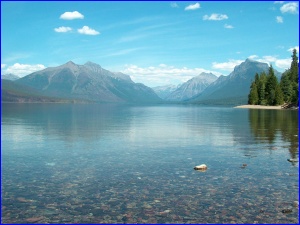 A blue miasma holds the scene within its gentle haze; sky, mountains and water depicted in various shades and tones. Across the undisturbed expanse of the lake, the mountains rise in the distance, their sharp outline highlighted against the sky and reflected in the watery mirror. Nearer to shore, the crystal clarity of the cool water reveals the red and grey rocks resting on the shelf edging the deeper expanse of this glacial gouge. It is a place of stillness and beauty, a place to recharge the soul and be at peace. It is special; Sterling and I met here, on the shores of Lake McDonald in Glacier National Park, Montana.
A blue miasma holds the scene within its gentle haze; sky, mountains and water depicted in various shades and tones. Across the undisturbed expanse of the lake, the mountains rise in the distance, their sharp outline highlighted against the sky and reflected in the watery mirror. Nearer to shore, the crystal clarity of the cool water reveals the red and grey rocks resting on the shelf edging the deeper expanse of this glacial gouge. It is a place of stillness and beauty, a place to recharge the soul and be at peace. It is special; Sterling and I met here, on the shores of Lake McDonald in Glacier National Park, Montana.
The water beckons and we wade out, its absolute transparency hiding the gradient, the level quickly reaching our knees. It is cold and then cool, its origins not to be forgotten. Back on the beach we skip stones out across the perfect surface momentarily breaking the sheen, watching the ripples of each bounce merge before returning to its original smoothness. We drop into the Lodge for old times sake, sitting on the large rustic rocking chairs on the back veranda sipping a G&T, being glad of that fateful day some years ago.
We spent the night at Avalanche Campground, as far along the valley as we can travel. The Going to the Sun road, crossing Glacier, has a length limit of twenty-one feet and even detached we are two inches over. The park service are keen in their policing of this matter, tape measures emerging at the entrance stations, approximations not accepted.
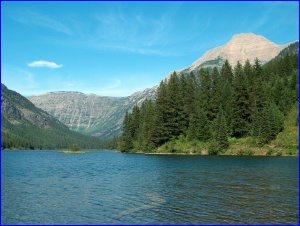 To those who see the park by road this stretch up and over Logan Pass is crucial. We were here to do a little walking and so it matters less although Sterling speculates about whether we could live in something even smaller than our existing shoebox.
To those who see the park by road this stretch up and over Logan Pass is crucial. We were here to do a little walking and so it matters less although Sterling speculates about whether we could live in something even smaller than our existing shoebox.
Sitting on the veranda of the lodge the tree covered slopes on the opposite side of the lake looked almost inconsequential, an invitation to a gentle stroll. The trail up to Trout Lake proved anything but, climbing two thousand feet in two miles before dropping another thousand down to the lake. In hindsight, all things are relative and we realized that the ridge manages its unassuming appearance in comparison to the surrounding peaks towering over it at eight thousand feet. Much of the trail cut across an area burnt in the massive wildfires of last year, charred and fallen trunks dot the valley sides, a healthy undergrowth the first sign of regeneration. Sunlight played across the vegetation and we caught an occasional glimpse of the lake below as we wended our way up. Down in the next valley the trail passed through substantial thimbleberry patches, beautifully ripe, red and juicy they were just the sort of dinner Mrs. Bear might be looking for; we walked quickly making plenty of noise as we went. While Trout Lake is one of the numerous water bodies set amidst surrounding mountains, it is by no means a particularly spectacular one. Nevertheless, ever-greened slopes reach down to perfectly clear water, avalanche scars look trim and neat from a distance, their lighter greens a contrast across the darker conifers, bare rock faces rise in sheer walls above the tree line, marked by the vertical lines of erosion. In most other contexts it would earn the epithet of amazing; only in the wider context of Glacier can it be seen as just another lake. It's major plus is that even at the height of the season it is deserted, the bulk of visitors off on the more popular trails. I'm not sure if I'd climb three thousand feet to see it again but that is probably as much to do with my memory of tired feet and gasping lungs as with the destination.
We left the park the next morning, heading for Kalispell where we were due to meet my sister Solanna at the airport that night. Last minute preparations filled our day, not least of which was Sterling's heroic cleaning of the outside of the rig. On the rare occasions that we stay in an RV park we are often mystified by the number of people who come out first thing in the morning and wipe the dew off their spotlessly clean units using a little cloth obviously designated specifically for the purpose. We have seen people arrive in a campground and proceed to wash their motor home before they even put the kettle on for a nice cup of tea. They follow this up by extensive rinsing and drying off, regardless of rain falling during the process. I have to assume that our approach of only washing the outside either when we are visiting or are going to be visited, or when the overall colour approximates the shade of the surrounding soil, must be a disgrace to the rest of the full-timing community.
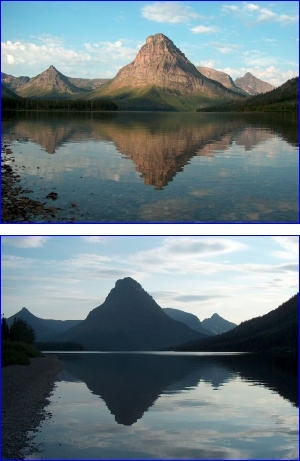 Whatever the case, Solanna arrived to a gleaming rig and was suitably impressed.
Whatever the case, Solanna arrived to a gleaming rig and was suitably impressed.
Two Medicine Lake in the southeast corner of the park was our first destination, and probably our favourite stop of the week. The mountains are immediate here, rising sharply around two sides of the lake, trees quickly vanishing leaving the bare slopes revealed. In the early morning light, the clear air brings a sharp crispness to the lines, the rock a gentle gold, the reflections still in the undisturbed surface. At the end of the day a monochrome version of the image emerges, cool tones rather than warm but every bit as beautiful in the still dusk.
The trail to Upper Two Medicine Lake is a varied path passing through the forested skirts of the mountains, out across sections of low-lying vegetation not far above the shore and then travelling up the valley from the head of the first lake to the toe of the next. Along the inter-lake section, avalanche damage is evident, the massive destructive force of falling snow and ice has left tree trunks snapped like matchsticks, much of the ground cleared for fresh growth.
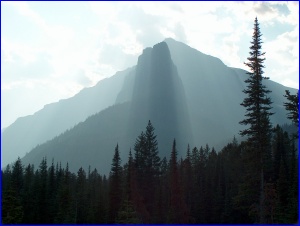 Tucked in the bottom of the valley the trail is towered over by the mountains, a thin line etched across the ground in this imposing landscape while above us cloud and shadow played tricks with the light bringing an epic like quality to certain peaks.
Tucked in the bottom of the valley the trail is towered over by the mountains, a thin line etched across the ground in this imposing landscape while above us cloud and shadow played tricks with the light bringing an epic like quality to certain peaks.
Having exercised the lower extremities, Solanna and I decide to work on the biceps and so headed for the boat rentals the next day while Sterling set off on another trail up to the tundra. We choose a two-person kayak and with the warning that we should hug the shore if the wind came up and white caps appeared, we set off. Sure enough, the wind came up and our inexperienced technique combined with the choppy water resulted in us sitting in small puddles and wet shorts before too long. Now I could embarrass you with the tale of my knicker-drying technique but suffice to say that when we finally came to shore at the end of our little sojourn, the wind blew them from the top of my hat and they landed in the middle of the car park where I fortunately spotted them before they shocked some inquisitive tourist. Meanwhile back on the water, the two miles to the head of the lake were hard going against the wind with a considerable influence being exerted by the waves breaking sideways onto the kayak and deflecting back from the shore. At the head of the lake, a stretch of perfectly still water shimmered with reflections, the images broken by our passage, the area protected by the saddle of land to the northeast. Being so close to the surface it is easy to feel immersed in the elements, the sky above, the mountains around and the water below. There are not many better ways to spend a couple of hours.
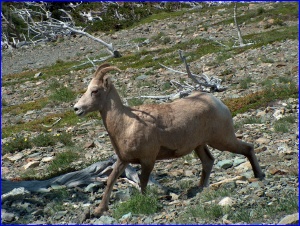 Sterling returned with tales of dramatic views, weird and wonderful trees, and a herd of bighorn sheep and decided to join us for a late afternoon dip. However, I have to report that it was only those members of the party, raised on the icy waters of the North Sea who ultimately took the plunge. While we did not have a thermometer handy for an official reading, you can take it from me that it was quite chilly and while the experience was invigorating it was also appropriately short.
Sterling returned with tales of dramatic views, weird and wonderful trees, and a herd of bighorn sheep and decided to join us for a late afternoon dip. However, I have to report that it was only those members of the party, raised on the icy waters of the North Sea who ultimately took the plunge. While we did not have a thermometer handy for an official reading, you can take it from me that it was quite chilly and while the experience was invigorating it was also appropriately short.
It was about this time that Solanna took up wrestling her suitcase on the picnic table. The origins of her peculiar behaviour have to be put down to the size of the camper. We simply do not have cupboard space to offer visitors and so her luggage had to live in the truck and be brought back and forth as needed.
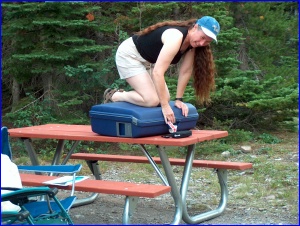 After a few such trips the bag refused to close but soon regretted its obstinance as the full weight of Solanna's determination was brought to bear on the situation. She remained in remarkably good spirits as she rearranged and repacked various bags losing track of half her belongings in the process and continually searching for crucial items in the process. The experience of three of us in the camper was cosy but workable, the dinette converting into a bed just about big enough for one average sized adult. If we had two visitors or if a tall person came to stay, we could be in trouble although we can always offer our backpacking tent as an alternative to sleeping with bent legs. The lack of space was exacerbated further by considerable rainfall culminating in us sitting beneath the awning watching our campfire slowly but surely die while the lightning illuminated the sky and the thunder reverberated off the surrounding mountains.
After a few such trips the bag refused to close but soon regretted its obstinance as the full weight of Solanna's determination was brought to bear on the situation. She remained in remarkably good spirits as she rearranged and repacked various bags losing track of half her belongings in the process and continually searching for crucial items in the process. The experience of three of us in the camper was cosy but workable, the dinette converting into a bed just about big enough for one average sized adult. If we had two visitors or if a tall person came to stay, we could be in trouble although we can always offer our backpacking tent as an alternative to sleeping with bent legs. The lack of space was exacerbated further by considerable rainfall culminating in us sitting beneath the awning watching our campfire slowly but surely die while the lightning illuminated the sky and the thunder reverberated off the surrounding mountains.
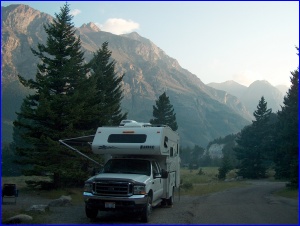 Our path took us north towards St. Mary where we stopped for a night at Rising Sun and on the way saw our first bear of the trip, gracefully crossing the road before plunging into a berry patch on the other side, which clearly answers the obvious question. The campground is a short walk from St Marys Lake and here we encountered a different sort of wildlife altogether. Two ducks dabbled in the shallow waters close to shore in the vicinity of what looked like and on closer inspection proved to be an animal carrier. In fact both birds were tethered to the box by a piece of string attached to one of their legs. While Solanna and Sterling thought this was perfectly normal, I had my doubts. Where had they come from, who did they belong to and more importantly, was this treatment acceptable to the Wildfowl Tourist Board who presumably had arranged the trip on their behalf?
Our path took us north towards St. Mary where we stopped for a night at Rising Sun and on the way saw our first bear of the trip, gracefully crossing the road before plunging into a berry patch on the other side, which clearly answers the obvious question. The campground is a short walk from St Marys Lake and here we encountered a different sort of wildlife altogether. Two ducks dabbled in the shallow waters close to shore in the vicinity of what looked like and on closer inspection proved to be an animal carrier. In fact both birds were tethered to the box by a piece of string attached to one of their legs. While Solanna and Sterling thought this was perfectly normal, I had my doubts. Where had they come from, who did they belong to and more importantly, was this treatment acceptable to the Wildfowl Tourist Board who presumably had arranged the trip on their behalf?
Our trip continued to the Many Glacier campground and to one of the most spectacular day hikes in the park.
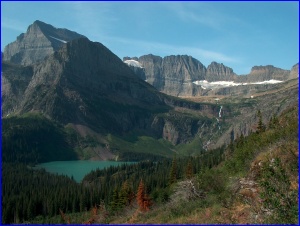 The trail up to Grinnell Glacier climbs clear of the forest and out across the vegetation of the higher slopes coloured by an amazing array of wildflowers. As the path continues up, the milky turquoise waters of Lake Grinnell come into view, filled by the melt-waters from the glacier further up the valley. Surrounded by dark green conifers the lake looks un-natural, its shade a startling quirk. Looking back down the valley, a string of lakes becomes visible from Sherburne down at the bottom through Josephine and up to the bizarre Grinnell. The glacier itself is small and in places blackened by remnants of rock that has fallen from the surrounding walls and now lies on the surface of the ice.
The trail up to Grinnell Glacier climbs clear of the forest and out across the vegetation of the higher slopes coloured by an amazing array of wildflowers. As the path continues up, the milky turquoise waters of Lake Grinnell come into view, filled by the melt-waters from the glacier further up the valley. Surrounded by dark green conifers the lake looks un-natural, its shade a startling quirk. Looking back down the valley, a string of lakes becomes visible from Sherburne down at the bottom through Josephine and up to the bizarre Grinnell. The glacier itself is small and in places blackened by remnants of rock that has fallen from the surrounding walls and now lies on the surface of the ice.
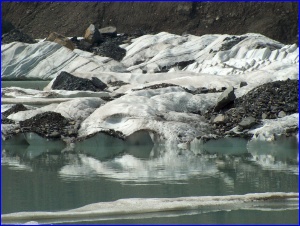 The immediate melt-water gathers in a small lake just below the glacier, the shade a pale grayish green, icebergs floating, the smaller ones slowly drifting in the gentle current. It is a truly magical destination and a great place to eat our sandwiches that by this time had been well and truly squashed at the bottom of our rucksacks. On the way back down, the trail on the north side of Lake Josephine had been closed as a bear and her cubs were busy picking the berries. For their safety and ours we made our way back along the opposite shore and were ready for a refreshing beverage by the time we got back to Many Glacier Hotel.
The immediate melt-water gathers in a small lake just below the glacier, the shade a pale grayish green, icebergs floating, the smaller ones slowly drifting in the gentle current. It is a truly magical destination and a great place to eat our sandwiches that by this time had been well and truly squashed at the bottom of our rucksacks. On the way back down, the trail on the north side of Lake Josephine had been closed as a bear and her cubs were busy picking the berries. For their safety and ours we made our way back along the opposite shore and were ready for a refreshing beverage by the time we got back to Many Glacier Hotel.
Our week was drawing to an end and we headed west again back to Lake McDonald where we spent our last night together before we dropped Solanna at a ranch where she was to spend the following week and we turned our wheels north for Canada.
| « Previous | [ Photos ] | [ Map ] | Next » |
Do you know someone who would enjoy this article? Click to e-mail it to them!
| Home | Log | Notes | Maps | Contact | Store |